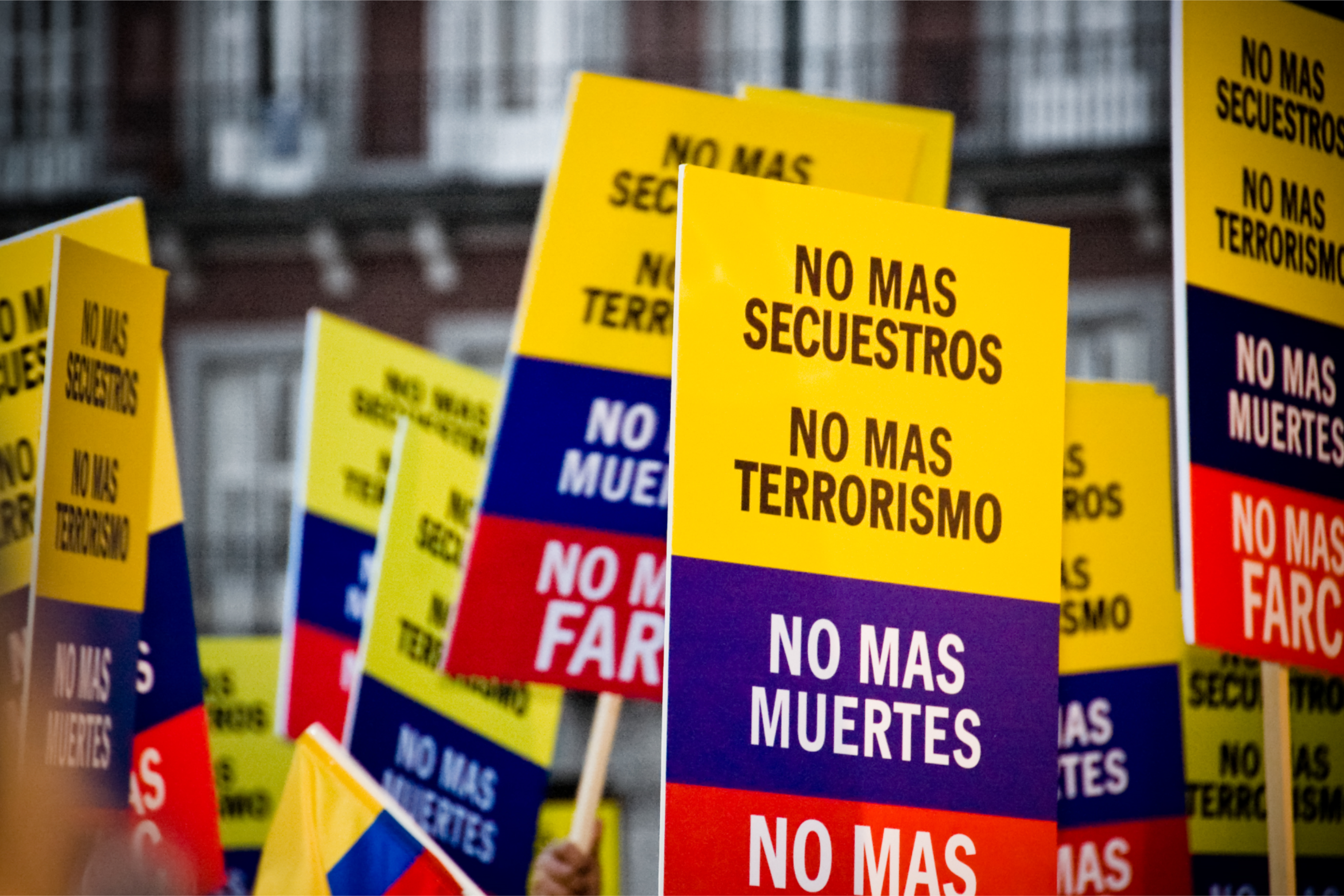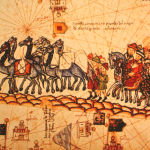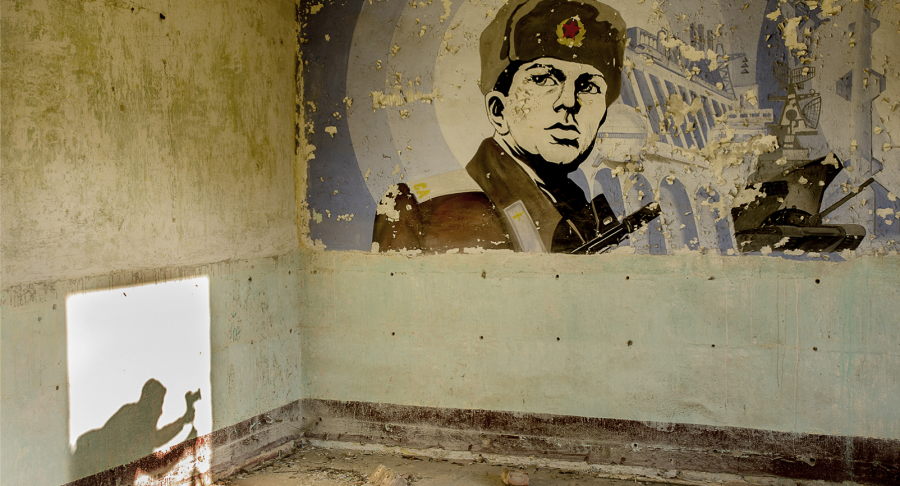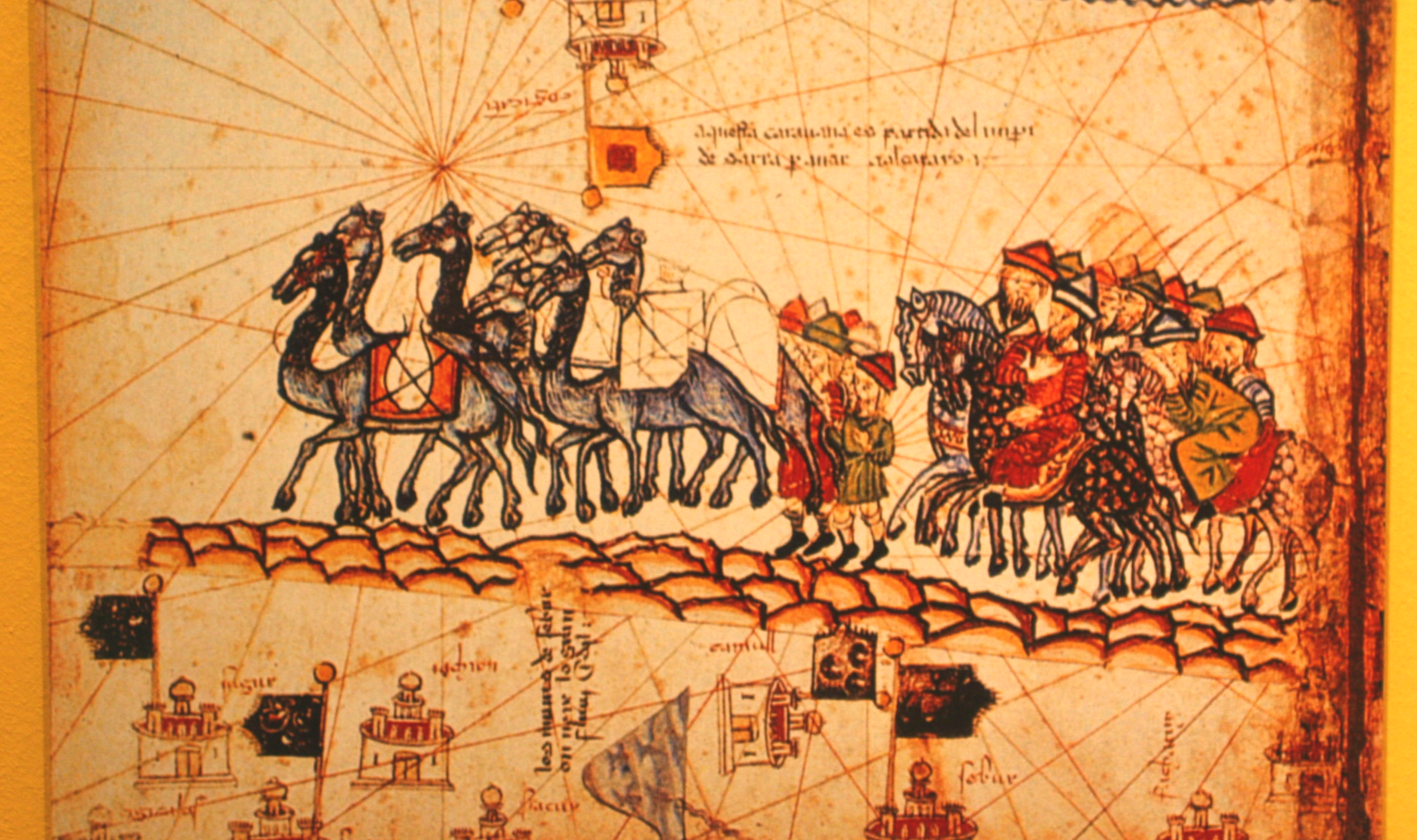With the new peace between the Colombian government and the FARC, the US should update Plan Colombia. A robust defense of property rights would be a good start.
While Colombia has struggled to maintain domestic control of the rule of law and has historically been one of the world’s largest producers of the drug cocaine, this summer marked a drastic change in the domestic Colombian scene. After more than four years of negotiations, the Colombian Government and a domestic communist revolutionary organization known as the FARC (Fuerzas Armadas Revolucionarias de Colombia [in English “Revolutionary Armed Forces of Colombia”]) reached a cease-fire agreement in August 2016. Although some question the peace’s feasibility, the prospect of peace raises the question of the necessity of US involvement in Colombia via what is known as Plan Colombia. Urged by President Clinton in 1999, Plan Colombia was the United States’ attempt to aid Colombia in reasserting the rule of law by funding Colombia operations against both the rampant drug trade and the FARC.3 Hailed by then president Andres Pastrana as the “Marshall Plan for Colombia,” the United States has been steadfast in supplying both military and economic aid to Colombia over the past 15 years. The United States sees Plan Colombia as an investment in Domestic Security. The current construction of the plan seeks to combat violence and prevent the drug trade from expanding in the drug hotbeds of Southern Colombia. With Colombian President Santos making a tour of the US earlier this year, one ranking member of the house committee on foreign affairs stated:
Since 2000, Democrats and Republicans have worked together to help the Colombian government fight terrorism, push back on the power of drug cartels, and enhance prosperity in the country. The results have been nothing short of extraordinary. As the Colombian government nears a historic peace agreement with the Revolutionary Armed Forces of Colombia (FARC) where the group lays down its weapons, we must double down on our assistance and make a multi-year commitment to the country. Just as we have supported Colombia through years of war, we should support it in peace. We must not forget the lessons of the recent past where we won the war and then, through lack of funding and misplaced priorities, lost the peace.4
However, over the last 15 years, the United States has only seen mixed results. Drug trafficking has been cut down only slightly, and at the same time, the people of Colombia are suffering from a corrupt government, a lack of property rights, and a growing discontent. In addition the new peace deal between Colombia and the FARC, the domestic violence is predicted to subside (although splinter groups will remain).8 As a result, the United States should adapt Plan Colombia to address the roots of Colombia’s problem, namely a weak government, human rights, lack of property rights, and an ineffective legal system.
History of the Colombian conflict
Colombia is a paradoxical historical study. It is one of the oldest uninterrupted democracies in South America, but at the same time it has been marked by outburst of violence and hundreds of thousands of deaths. Its history is marked by these interconnected elements.5 Colombia was one of three nations born out of Gran Colombia after the death of Simone Bolivar, the South American George Washington. The new Colombia was marked by stark inequality between the landed gentry (hacendados) and the common workers (colonos), and this manifested itself in constant battles between the conservative and liberal parties. Although Colombia’s independence from Spain in 1819 freed the country from colonial exploitation, throughout much of the nineteenth century Colombia retained the economic systems left by the Spaniards. Gold mining continued as the only means of generating foreign exchange.6 As a whole, the country was fragmented and the markets were small and local in nature. Although some reforms in the latter nineteenth century tries to generate structural change, these reforms actually stifled economic growth due to the export sector’s inability to grow.6
Until World War I, the Colombian economy relied primarily on the export of single commodities. The first was gold, then tobacco, and then coffee (which to this day remains one of the most common Colombian exports, behind petroleum and coal).12 When world prices were high for these goods, the economy into an upswing. When the prices fell, Colombia was forced to rely on home production, but small, isolated, local markets interfered with all attempts at industrial development. Colombia’s transportation infrastructure was virtually nonexistent, and its domestic saving was low because of a haphazard banking system, economic instability, and political upheavals.6 Foreign investment flows, mainly from British investors, were unreliable and small, and Colombian defaults were a common occurrence.6 However, compared to its neighboring nations, Colombia has enjoyed relative prosperity over the last 100 years. Between 1945 and 1995, its economy grew at an annual average rate of almost 5%. In addition, they were able to avoid the deep economic recession that affected most Latin American countries during the 1980s.13
Colombia has long been marked by an understanding of democratic principles, but at the same time the 19th and 20th centuries have been filled with violence and upheaval. One of the first nations to implement male suffrage in 1853, political power was centralized with those who were in power and did not leave a party which was in control till that party split and allowed another to take over power.5 Since the mid-19th century, two parties have been dominant in the political sphere: the conservatives, comprised of landowners, and the liberals, who are comprised of the reform-minded peasants. While they both are comprised of ruling elites who in name differ on economic policy and social justice, the main difference between the two parties is the role of the Established Catholic Church in politics.9 In 1958, the leaders of the two major liberal and conservative political parties created a political accommodation, the National Front, in order to promote peace and avoid unnecessary conflict over power changing hands. This plan required the alternation of the presidency by the two major parties, and the equal sharing of the governmental positions for a total of 16 years.7 As Carmenza Gallo states in his paper “Institutions and the adoption of rights: political and property rights in Colombia” in Theory and Society 39:
“Popular elections with limited party competition were stable because the National Front solved some of the most contentious economic distributional issues that could result from elections. In particular, the National Front pact addressed critically disputed issues that had bitterly divided the parties and the economic elites: use of the governmental machinery and the military to enhance the power of the party in power and the land tenancy system. Partly because the pact made the economic elites confident that state agents would not seize land or redistribute it through land reform, elections continued largely undisturbed.”7
However, this monopoly of power and land in the hands of elites in political parties bred the birth of paramilitary and revolutionary groups in the 1960s. Inspired by the Cuban Revolution and Marxist ideologies, these groups fueled a new wave of violence and terrorism that continues to this day. Two of the most noteworthy groups are the FARC and the ELN (Ejercito de Liberacion Nacional).5 While at first extremely idealistic and claiming to want to build a “Colombia for Colombians,” these groups were funded by communist nations in an attempt to change the Colombian state to communist principles. However, as the money stopped flowing in the 1980s and 1990s, these groups discovered the value of the southern Colombian farmland for raising drug cash crops for export to western nations like the United States, and capitalized on the poor farmers who were willing to grow the crops in exchange for “protection.” In addition, they supplemented their income with kidnappings and other crimes, wagging a “dirty war” of attrition.10 This situation of the expansion of illicit economic activities intensified in the late 1980s. 7 Still, in 1999 the country faced a deep economic crisis. In spite of a weak or possibly even failing state, and a dismal record in protecting political dissidents, the constitutional reforms of 1991 invigorated democratic practices, drastically decentralizing a historically deeply centralized state.7 This democratic reform along with the illegal drug trade that was primarily shipped into the United States paved the way for an increased relationship with the United States and the birth of Plan Colombia.

Creation of Plan Colombia
According to Noam Chomsky in his book Rogue States, “Plan Colombia” was a two-year Colombian government program of $7.5 billion, with the US providing the military muscle and token funds to fight against the drug trade and reestablish rule of law.11 Announced by Colombian President Andres Pastrana in 1999, Plan Colombia was designed to counter the country’s drug and security crisis through a comprehensive 6-year, $7.5 billion plan linked to three objectives: (1) reduce the flow of illicit narcotics and improve security, (2) promote social and economic justice through legislative and justice system reforms, and (3) promote the rule of law. While the latter two objectives were not specifically designed to reduce the flow of illicit narcotics and improve security, they were supposed to facilitate these goals by addressing some of the underlying social and economic realities that drove individuals toward the illicit drug trade by providing a legal framework for bringing drug traffickers and terrorists to justice. It did so by removing the drug money corruption that ran rampant in the Colombian legal system, and making the system more open and accountable to the people.14
One of the most notable features of Plan Colombia has been its longevity through several US presidential administrations. Although it was not the first time that America had authorized payments to Colombia for its economy (see for example the $25 million payment by the US to Colombia for Panama which restructured the Colombian economy in the 1920s), Plan Colombia has been by far the longest and most far-reaching external working of the US in South America in the recent past.6 Since it first started in the year 2000, Plan Colombia has become shorthand for wide-ranging U.S. cooperation with Colombia to assist that country in combating drugs, guerrilla violence, and related institutional and social problems. In the past few years, the US has spent nearly $8 billion on Plan Colombia, which is the most dollars spent in any country in the world outside of the Middle East, Iraq, and Afghanistan since the end of the Cold War.15
A New Phase for Plan Colombia
With Plan Colombia now entering its 15th year and crossing three presidential administrations in both Colombia and the United States, the main purposes of Plan Colombia are currently as follows: stop the drug flow into the United States from Colombia, cut down the cultivation of drug crops, curb violence and crime, remove the prospect of armed conflict and terrorist activity in Colombia, promote economic development, promote of Democracy, Rule of Law, and Human Rights, and protect regional stability.16 This came as a result of a directional change in 2007 from aid based primarily for combating narcotrafficking, to reconstructing the Colombian infrastructure. The National Consolidation Plan (Plan Nacional de Consolidación, PNC) is the newest phase of Plan Colombia, and it attempts to establish state presence in traditionally ungoverned spaces. By improving access to social services such as the justice system, education, and housing and health, while strengthening democracy and supporting economic development through sustainable growth and trade, the Colombian Government seeks to permanently recover Colombia’s historically marginalized rural areas from illegal armed groups and halt the cycle of violence. Since 2007, nearly $570 million have been invested only in socio-economic and humanitarian assistance to Colombia.17 The Colombian government has been able to reestablish control of contested land and force several groups of rebels to disarm themselves (including most recently the ELN), but the Plan Colombia has not seen much economic success. While there has been measurable progress in Colombia’s internal security (as indicated by decreases in violence, kidnappings, and killings, the eradication of drug crops, and decrease in corruption in the justice system), no effect has been seen regarding the price, purity, and availability of cocaine and heroin in the United States.
This lack of headway in the Colombian counternarcotic measures is due to the fact that Plan Colombia fundamentally does not change the incentives of the drug trade; it only tries to eradicate the trade itself. The Colombian drug trade can turn profits of over 2000% from farm to street, since one kilogram of cocaine costs $585-780 to create and can be sold in the US for $22,00-25,000. In addition, the risk of being caught is low since there is an established drug running route.18 Whenever the US and Colombia bust a drug operation, it simply moves to a different part of the country. Rural farmers are given profits of up to $15,000 US dollars to grow drug crops (a proverbial fortune in the rural areas of Colombia), so there is little incentive to stop growing. In addition, many solders take cuts out of the drugs that they capture, and resell it on the black market.19
Another unintended consequence was the establishment of private armies. Once the state showed that it could not, or was not willing to defend land property, established land owners created private armies to secure their own private property. But these landowners over time saw the money that could be made by selling drug cash crops and then themselves became drug barons, initiating a circle of increasing violence and criminality that overwhelmed the civil and justice system and undermined confidence in the state capacity to defend almost any kind of citizenship rights.19 Crumbling property rights in the countryside expelled close to 1.5 million peasants from their lands since 1991, and killed over 35,000 in armed conflicts that were largely centered on the control of land. These individual forced off their land usually went to the already overcrowded cities.18 A continued lack of property rights has led to another unintended consequences of Plan Colombia, an increase in illegal mining. Colombia has many natural resources such as gold and coal, but there are strict regulations with regard to mining it. However, rebel groups have started illegal mining operations as their drug operations have been threatened.19 Whereas drugs can take months to grow and process, illegal gold operations can mine up to two kilograms of gold a week with little previous knowledge.20
Although the Colombian state has been able to reassert itself, Plan Colombia has produced nothing new for property rights or informal institutions in Colombia. Colombia has always suffered from a weak state with weak formal institutions that have been prone to corruption and have helped foster organized crime and other criminal activities. One potential answer for why Colombia has weak formal institutions is the geographic complexity of the state. The rugged territory makes it more difficult for the Colombia state to assert control over rural areas. The Colombian state has never had complete control and the vast rural territories have helped foster the guerrilla organizations.21 This has created decades of mistrust in the government by the common people, and the informal institutions match this wary outlook. There is little internal investment outside of the cities, and the rural areas remain untouched by modern development. Outside of the urban areas, property rights are almost non-existent, where “squatter’s rights” are the definitive measure of farmland. Several studies analyzing the regional distribution of violent activities in Colombia show that the most violent regions are those where property rights are challenged. Challenges to property rights come from three sources: (a) colonization of marginal frontier lands by peasants displaced from richer lands; (b) illegal mining and illegal agriculture; (c) the acquisitions of land that had been settled previously by peasants without land titles.7
In many cases, rural areas were settled by peasants without titles and in frontier territories where the administrative and judicial reach of the state was weak. However, the state’s weak capability to punish illegal transactions generated incentives to expand illegal activities and challenge property rights in rural areas. Illicit crops expanded very quickly, about 400% between 1978 and 1998.7 Changes in land ownership also occurred in regions with large and underutilized tracts of lands owned by traditional hacendados (established landowners) who, threatened by the guerrillas, would sell their property as well as the land occupied by colonos (squatters), to drug traffickers. The crisis of property rights brought about by rapid changes in land ownership and possession, resulted in the emergence of a new landed elite, composed of owners whose capital was illegally obtained and members of paramilitary forces who took land by force.
Conclusion – Looking to the Future
With the new peace between the FARC and the Colombian government, the United States is going to have to overhaul its framework for Plan Colombia. Although the need for US funds to combat domestic Colombian violence will subside, half a century of conflict has necessitated a revamping of economic development in Colombia which includes a substantial defense of property, besides reaffirming the Rule of Law and Human Rights after decades of murder and abuse. According to Carmenza Gallo, “the role of the state in enacting and defending property is extensive and expensive. It must include among other entities a police and an army, criminal courts, and an extensive bureaucracy in charge of recording, surveying titles, and registering transaction, etc.”7 Plan Colombia should be reoriented towards these important ends rather than continuing to throw money at a failing system of combatting the drug trade. Colombia and the US are fighting an uphill battle, and are going to continue to not make headway until they start to enable alternative economic choices to farmers in the Southern states of Colombia.18
The demobilization of rightist paramilitary fighters is proceeding, but without a legal framework governing the process. Critics of U.S. policy argue that respect for human rights by the Colombian security forces is still a problem, and that counternarcotic programs have negative consequences for the civilian population.7 Meanwhile, democracy continues to drag its bloodied heels in the country. Today, over 70% of Colombians now live in an urban environment due to nearly 50 years of fighting between the Marxist revolutionaries of the FARC and the legitimate government. This has led to one of the highest cases of national income inequality in the world, social unrest and tends to restrict foreign direct investments, and a national crisis is brewing as the Middle class continues to shrink.13
With the birth of a tentative peace, President Obama has already begun discussions as to the modification of Plan Colombia to complement any peace agreement that could include almost $1.5 billion in additional U.S. aid.2 The current Colombian Administration’s foreign policy has focused on bolstering Colombia’s commercial ties and boosting investment at home. Colombia has signed or is negotiating Free Trade Agreements (FTA) with more than a dozen countries; however, most of its trade is with the United States, with which it has a Bilateral Investment Treaty. The United States and Colombia have benefitted from a FTA, but Colombia’s ability to take full advantage of its enhanced access to American markets continues to be constrained by lack of export diversification.12 This focus on growth presents an opportunity for the United States, as one of the global economic hegemons, to open up Colombia as a viable partner in international trade, and enable the Colombian people to move out of an era of violence into an new epoch of peace. ■
- Burn Notice, “The Fall of Sam Axe,” Season 5, Episode 1. Directed by Jeffrey Donovan. Written by Matt Nix. USA network, June 22, 2012.
- Jose R. Cardenas, “Plan Colombia Shouldn’t be the Price of Peace with the FARC,” Foreign Policy, 1 February 2016, www.foreignpolicy.com/2016/02/01/plan-colombia-shouldnt-be-the-price-of-peace-with-the-farc
- Uri Friedman, “Foreign Policy: A Brief History of Plan Colombia,” NPR.org, 1 November 2011, www.npr.org/2011/11/01/141900629/foreign-policy-a-brief-history-of-plan-colombia
- Eliot L. Engel, “Engel Statement on 15th Anniversary of Plan Colombia,” 3 February 2016, www.democrats-foreignaffairs.house.gov/news/press-releases/engel-statement-15th-anniversary-plan-colombia
- Peter Waldmann, “Colombia and the FARC: Failed attempts to stop violence and terrorism in a weak state,” in Democracy and Counterterrorism: Lessons from the Past, Robert J. Art, Louise Richardson, eds. Washington, D.C.: United States Institute of Peace Press, 2007.
- Bruce R. Dalgaard, “Monetary Reform, 1923-30: A Prelude to Colombia’s Economic Development,” The Journal of Economic History 40, No. 1 (March 1980): 98-104. www.jstor.org/stable/2120429 (accessed April 18, 2016)
- Carmenza Gallo, “Institutions and the adoption of rights: political and property rights in Colombia,” Theory and Society 39, No. 3 (May 2010): 415-431. www.jstor.org/stable/40587543 (accessed April 18, 2016)
- Megan Alpert, “Politics Roils Colombia’s Tentative Peace Deal With the FARC,” Foreign Policy, 18 July 2016, www.foreignpolicy.com/2016/07/18/politics-roils-colombias-tentative-peace-deal-with-the-farc-eln-santos-uribe/
- Keith Stanski, “Terrorism, Gender, and Ideology: A Case Study of Women who Join the Revolutionary Armed Forces of Colombia (FARC),” in James J.F. Forest, The Making of a Terrorist: Recruitment, Training, and Root Causes, Vol. 1. Westport, CT: Praeger Security International, 2006.
- Jamie L. Tyson, “Colombia: Estimating the Collapse of the Pastana Presidency,” in Jan Goldman, ed., Dangerous Assumption: Preparing the US Intelligence Warning System for the New Millennium. Washington, DC: Joint Military Intelligence College, 2000.
- Norm Chimsky, Rogue States: The Rule of Force in World Affairs. Cambridge, MA: South End Press, 2000.
- CIA World Factbook, “Colombia,” last updated 7 September 2016, www.cia.gov/library/publications/the- world-factbook/geos/co.html
- Michael Shally-Jensen, ed., Countries, Peoples, and Cultures: Central and South America, Vol. 1. Ipswich, MA: Salem Press, 2015.
- U.S. Government Accountability Office. Plan Colombia: Report to the Honorable Joseph R. Biden, Jr., Chairman, Committee on Foreign Relations, U.S. Senate. Washington, DC: U.S. Government Accountability Office, October 2008.
- Michael Shifter, “Plan Colombia: A Retrospective,” Americas Quarterly (Summer 2012)www.americasquarterly.org/node/3787 (accessed May 1, 2016)
- Connie Veillette, Plan Colombia: A Progress Report. Washington, DC: U.S. Library of Congress, Congressional Research Service, June 22, 2005.
- US Department of State, “Plan Colombia,” United States Embassy to Colombia, www.bogota.usembassy.gov/plancolombia.html (accessed May 1, 2016)
- Scott Stewart, “From Colombia to New York City: The economics of cocaine,” The Business Insider, 27 June 2016, www.businessinsider.com/from-colombia-to-new-york-city-the-economics-of-cocaine-2015-7
- Natalio Cosoy, “Has Plan Colombia really worked?” BBC News, 4 February 2016, www.bbc.com/news/world-latin-america-35491504
- Andrew Willis, “Gold Beats Cocaine as Colombia Rebel Money Maker: Police,” Bloomburg.com, 21 June 2013,www.bloomberg.com/news/articles/2013-06-21/gold-beats-cocaine-as-colombia-rebel-money-maker-police (accessed May 20, 2016)
- Jonathan D Rosen, “Plan Colombia and Beyond: Pastrana to Santos (2000 to 2012),” (Ph.D diss., University of Miami, 2012).
Image credits —
- Colombian Army personnel © Wikimedia Commons | https://commons.wikimedia.org/wiki/Category:Army_of_Colombia#/media/File:Ejercito_de_colombia.jpg
- No More Terror posters © Camilo Rueda Lopez | https://www.flickr.com/photos/kozumel/2245170100




